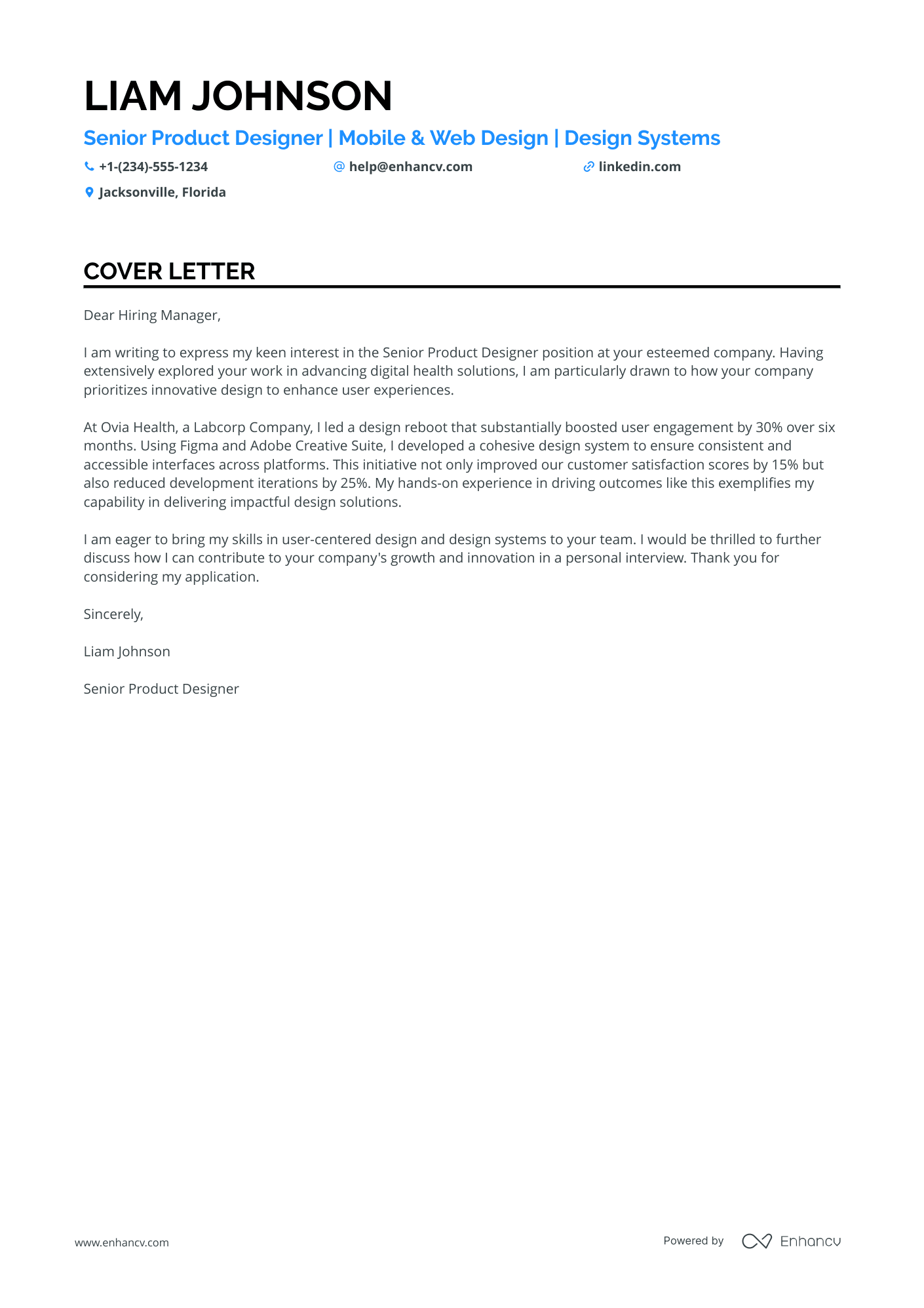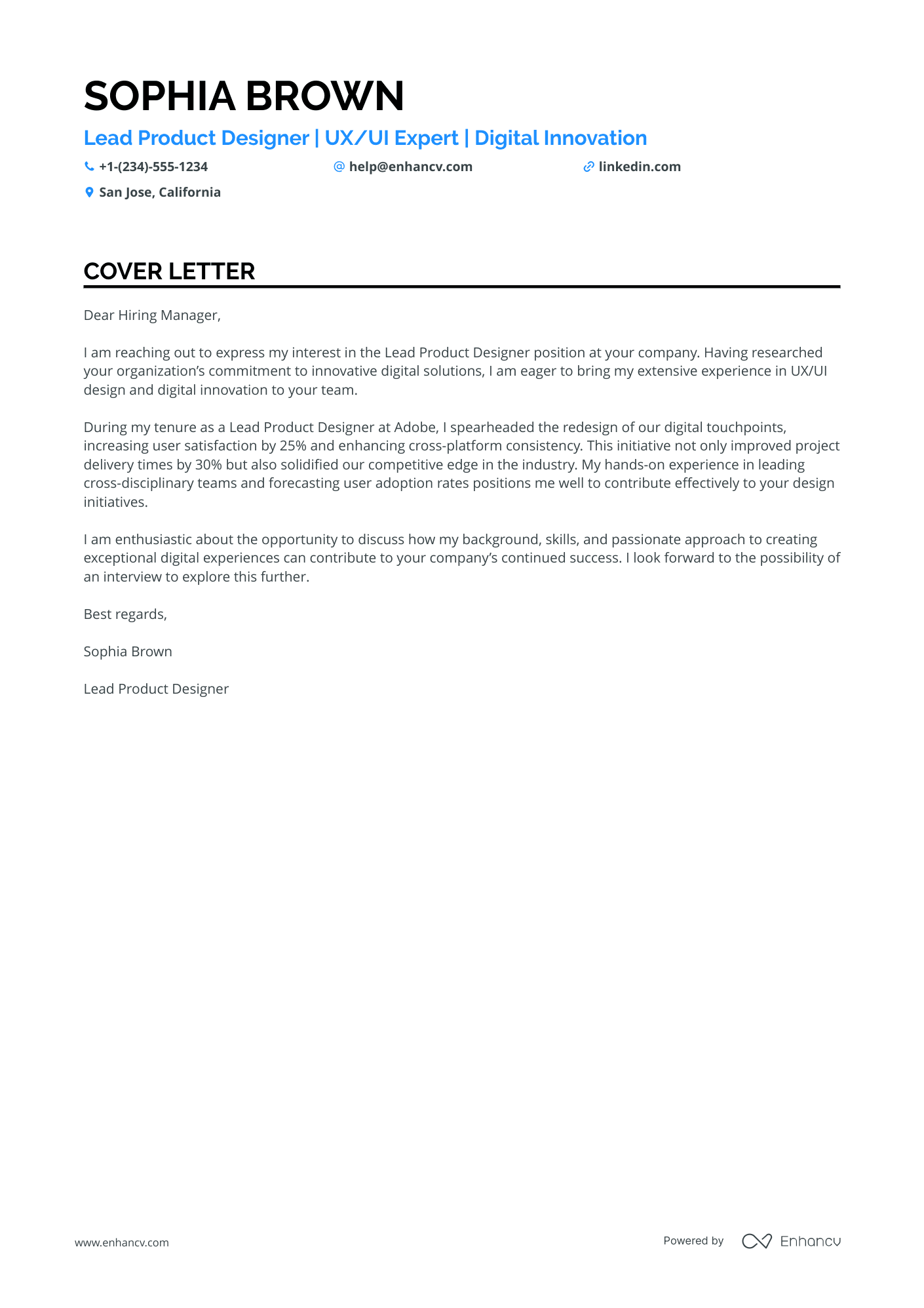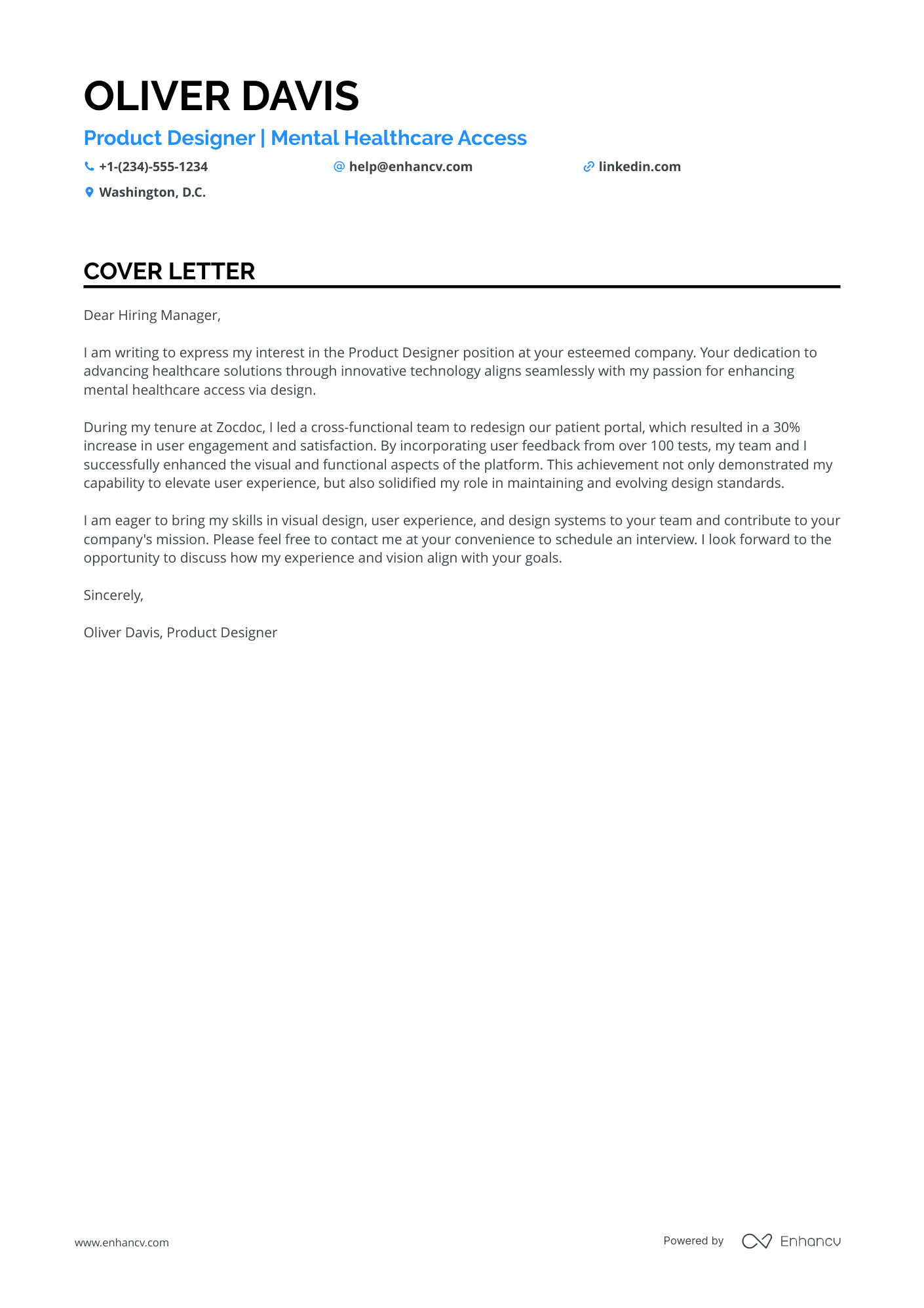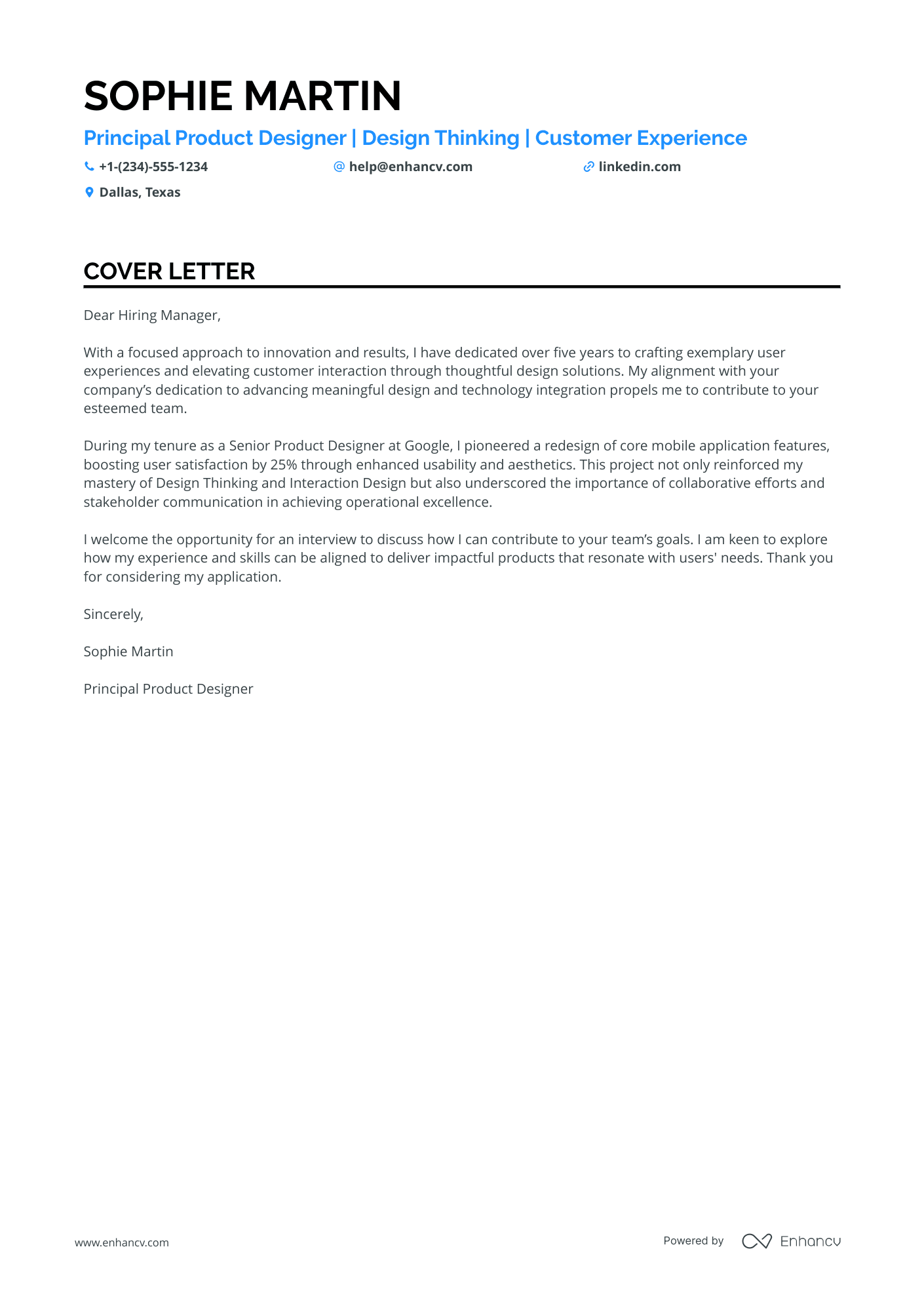Crafting a product designer cover letter can be a daunting task, especially if you're deep into job hunting and realize it's a requirement you can't sidestep. Your cover letter is your narrative spotlight, not a resume echo. It's your chance to weave a compelling story around your proudest professional achievement. To strike the right balance, ditch the clichés, keep it concise—no more than a single page—and maintain formality without losing your personal touch.
- Making excellent use of job-winning real-life professional cover letters;
- Writing the first paragraphs of your product designer cover letter to get attention and connect with the recruiters - immediately;
- Single out your most noteworthy achievement (even if it's outside your career);
- Get a better understanding of what you must include in your product designer cover letter to land the job.
Let the power of Enhancv's AI work for you: create your product designer cover letter by uploading your resume.
If the product designer isn't exactly the one you're looking for we have a plethora of cover letter examples for jobs like this one:
- Product Designer resume guide and example
- Game Designer cover letter example
- Retail Designer cover letter example
- Footwear Designer cover letter example
- Electrical Designer cover letter example
- Narrative Designer cover letter example
- Production Designer cover letter example
- Industrial Design cover letter example
- Junior Graphic Designer cover letter example
- App Designer cover letter example
- Assistant Video Editor cover letter example
Drop your resume here or choose a file.
PDF & DOCX only. Max 2MB file size.
Product designer cover letter example
Ethan Smith
Austin, Texas
+1-(234)-555-1234
help@enhancv.com
- Emphasizing measurable achievements such as increasing user engagement by 30% showcases the candidate's capability to deliver concrete results, which is critical for a product designer role.
- Incorporating specific strategies used in past roles, such as leveraging user feedback and A/B testing, demonstrates the candidate's hands-on experience and knowledge of effective user experience design practices.
- Expressing alignment with the company's vision highlights the candidate's research into the company values and shows a shared passion for user-centered design, fostering a sense of camaraderie and fit with the team's culture.
- The desire to discuss the candidate’s background, skills, and how they align with the company’s projects reiterates eagerness for collaboration and indicates the candidate's proactive approach and interest in contributing to the team's success.
Structuring and formatting your product designer cover letter
Here's what the structure of your product designer cover letter should include:
- Header (with your name, the position you're applying for, and the date);
- Salutation (or greeting);
- Introductory paragraph (or your opening statement);
- Body paragraph (or further proof of your experience);
- Closing paragraph (with a call to action);
- Signature (that is optional).
Use the same font for your product designer resume and cover letter - modern fonts like Lato and Rubik would help you stand out.
Your product designer cover letter should be single-spaced and have a one-inch margins - this format is automatically set up in our cover letter templates and our cover letter builder.
When submitting your cover letter, always ensure it's in PDF, as this format keeps the information intact (and the quality of your document stays the same).
On one final note - the Applicant Tracker System (ATS or the software that is sometimes used to initially assess your application) won't read your product designer cover letter.
Writing cover letters just got easier. Use our free cover letter generator to create yours instantly.
The top sections on a product designer cover letter
- Header with Contact Information: Including a professional header with your contact information makes it easy for the recruiter to know who you are and how to reach you, which is fundamental for any follow-up correspondence.
- Greeting with Personalization: Addressing the recruiter or hiring manager by name shows that you've done your research and are genuinely interested in the company, fostering a personal connection from the outset.
- Introduction with Design Passion Statement: Open with a brief introduction that expresses your passion for product design and how it aligns with the company's mission or design philosophy; this sets the stage for your application's narrative.
- Body Highlighting Design Experience and Skills: In a couple of succinct paragraphs, focus on specific product design projects you've completed, unique design skills you possess, and how you've collaborated with teams, as these are key qualities that recruiters look for in a product designer.
- Closing with Call to Action: End with a proactive closing that reiterates your enthusiasm for the position and invites the recruiter to engage in further discussion, thereby showing eagerness to move through the hiring process.
Key qualities recruiters search for in a candidate’s cover letter
- Proficiency in Design Tools: Mastery of industry-standard design software like Sketch, Adobe Creative Suite, Figma, and InVision, showcasing technical skills necessary for creating visual materials and prototypes.
- Understanding of User-Centered Design: Demonstrating a deep understanding of user experience (UX) principles, user research methodologies, and a portfolio that exhibits a strong dedication to solving real user problems through design.
- Strong Aesthetic Sense: Having a well-developed sense of visual design demonstrated through a keen eye for typography, color theory, and composition, which is crucial for creating visually appealing products.
- Cross-Functional Collaboration: Experience in working closely with engineers, product managers, and other stakeholders to ensure design concepts are feasible and aligned with business goals, highlighting teamwork and communication skills.
- Problem-Solving Ability: Evidence of a strategic mindset and an ability to tackle complex design challenges, converting them into simple, elegant solutions, which is core to product design success.
- Iterative Design Process: A history of using an iterative approach to design, including rapid prototyping, frequent user testing, and agile development practices, to continuously improve and refine product designs.
Greeting recruiters with your product designer cover letter salutation
What better way to start your conversation with the hiring manager, than by greeting them?
Take the time to find out who the professional, recruiting for the role, is.
Search on LinkedIn, the company website. And for those still keen on making a fantastic first impression, you could even contact the organization, asking for the recruiter's name and more details about the job.
Address recruiters in the product designer greeting by either their first name or last name. (e.g. "Dear Anthony" or "Dear Ms. Smarts").
If you're unable to discover the recruiter's name - don't go for the impersonal "To whom it may concern", but instead use "Dear HR team".
List of salutations you can use
- Dear Hiring Manager,
- Dear [Company Name] Team,
- Dear Mr./Ms. [Last Name],
- Dear [Job Title] Search Committee,
- Dear [Department Name] Hiring Team,
- Dear [Job Title] Hiring Manager,
The product designer cover letter intro: aligning your interest with the company culture
You only have one chance at making a memorable first impression on recruiters with your product designer cover letter.
Structure your introduction to be precise and to include no more than two sentences.
Here are some ideas on how to write a job-winning product designer cover letter introduction:
- get creative - show off your personality from the get-go (if this aligns with the company culture);
- focus on your motivation - be specific when you say what gets you excited about this opportunity.
How to select your best achievement for the middle, or the product designer cover letter body
You probably feel exhausted by this point in your application: you've dived into all the details of your success and skills in your product designer resume.
What else can you include in your product designer cover letter body?
Well, for starters, the next three to six paragraphs should show you further value as a professional. Or, why should recruiters choose you?
Think back on a noteworthy achievement that answers key job requirements and dive deep.
Structure your product designer cover letter middle as you'd a story: following chronological logic and highlighting outcomes, thanks to skills.
At the end of the day, you'd want recruiters to be able to see you as the best candidate for the role and understand more about who you are and what makes your success unique (and valuable to the role).
Ending your product designer cover letter: a closing paragraph with a promise
If you're thinking of finishing your product designer cover letter with a "Sincerely yours" or "Thanks for the consideration," you need to read on.
End the final paragraph of your product designer cover letter with a twist:
- a promise - of how you'd grow as a professional, part of the company, or improve organizational metrics;
- a call to action - prompt interviewers with some follow-up actions if they are interested in your profile.
A personalized ending would surely help you to stand out by being a memorable candidate.
Is it beneficial to mention that you have no experience in your product designer cover letter?
Lacking professional experience isn't the end of the world for your product designer cover letter.
Just be honest that you may not have had roles in the industry, but bring about so much more.
Like, your transferable skills, attained thanks to your whole work and life experience (e.g. the skills your summer spent working abroad taught you).
Or, focus on what makes you, you, and that one past success that can help you stand out and impress recruiters (think of awards you've attained and how they've helped you become a better professional).
Alternatively, write about your passion and drive to land the job and the unique skill set you would bring to enhance the workplace culture.
Key takeaways
Writing your product designer cover letter doesn't need to turn into an endless quest, but instead:
- Create an individual product designer cover letter for each role you apply to, based on job criteria (use our builder to transform your resume into a cover letter, which you could edit to match the job);
- Stick with the same font you've used in your resume (e.g. Raleway) and ensure your product designer cover letter is single-spaced and has a one-inch margin all around;
- Introduce your enthusiasm for the role or the company at the beginning of your product designer cover letter to make a good first impression;
- Align what matters most to the company by selecting just one achievement from your experience, that has taught you valuable skills and knowledge for the job;
- End your product designer cover letter like any good story - with a promise for greatness or follow-up for an interview.
Product Designer cover letter examples
By Experience
Senior Product Designer
- Highlighting relevant past experiences with quantifiable outcomes (e.g., boosting user engagement by 30% and improving customer satisfaction scores by 15%).
- Mentioning specific skills and tools required for the job, such as proficiency in using Figma and Adobe Creative Suite.
- Expressing genuine interest and alignment with the company's mission and work, showing research and connection to the company's goals.
- Offering to discuss contributions in a personal interview, demonstrating openness to further engagement and discussion.
Lead Product Designer
- Highlighting Relevant Experience: The applicant clearly emphasizes their past experience in a similar role (Lead Product Designer at Adobe) which directly applies to the position they are applying for.
- Quantitative Results: By providing specific metrics (e.g., increased user satisfaction by 25%, improved delivery times by 30%), the candidate effectively demonstrates their impact and achievements.
- Alignment with Company Values: The cover letter connects the applicant’s personal goals with the company’s commitment to innovative digital solutions, showing genuine interest and potential cultural fit.
- Proactive Engagement: Expressing eagerness to further discuss their skills and experiences in an interview displays initiative and confidence.
Junior Product Designer
- Alignment with Company Mission: Clearly articulate how your personal goals or passions align with the company's mission or values. This helps establish a connection and shows genuine interest in the role.
- Specific Achievements: Include concrete examples of previous work or projects that have resulted in measurable outcomes, such as increased user engagement or satisfaction. This demonstrates the applicant’s effectiveness and impact.
- Cross-functional Collaboration: Highlight the ability to work with cross-functional teams. Collaboration is often essential in roles like product design, where integrating various inputs can enhance the final product.
- User-Centric Approach: Emphasizing a user-focused methodology, like conducting user tests and incorporating feedback, showcases a commitment to continuously improving the user experience, which is critical in product design roles.
By Role
Principal Product Designer
- Mentioning specific past achievements, such as the increase in user satisfaction by 25%, helps to quantify the impact of one's work and demonstrates tangible results.
- Highlighting experience with relevant methodologies like Design Thinking and Interaction Design speaks directly to the skillset required for a Product Designer role, emphasizing industry-specific knowledge.
- Addressing a shared commitment to innovation and user-centric design aligns personal career goals with the company’s mission, showing a cohesive fit between the applicant and the organizational culture.
- Emphasizing collaborative efforts and stakeholder communication underscores the importance of teamwork and soft skills necessary for successful project execution in design roles.













